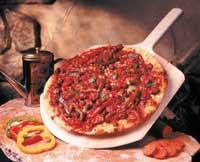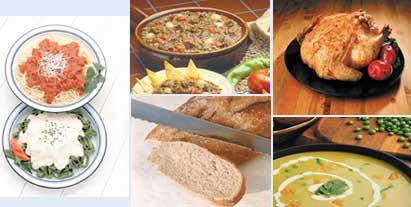Feeding in adolescence
The energetic need of a teenager depends on physical exercise and time of development. However, adolescence is the time when more energy is needed in life.

The distribution of this energy should be: 50-55% carbohydrates, 30% fat and 15-20% protein. The needs of the latter depend also on the time of development, but in adolescence more proteins are needed than in any other age because new tissues are forming.
The following table shows the recommended energy and protein needs for this time.
If we look at the feeding of most children in developed countries, we can highlight the following characteristics:
Recommended energy and protein needs for adolescence
In general they do not lack proteins, they take a fairly adequate amount, but often appear imbalances, since they consume more fat than necessary and less complex carbohydrates than necessary.
To avoid it and maintain a balanced diet it is necessary to include in the daily diet cereals, bread, fruit and vegetables, and remove the cookies and pastries, which contain a lot of simple fat and carbohydrates. Numerous investigations have warned that some adolescents, especially the girls, have taken the bad habit of abandoning the bread. However, for a balanced diet it is necessary to maintain an adequate level of carbohydrates, consuming mainly the four foods mentioned above.
On the other hand, mineral salts and vitamins play a very important role in adolescent development and in general health. Calcium and iron are the most important for this time.
Calcium: calcium: calcium: calcium Due to muscle and bone development, the need for this mineral salt is greater in adolescence than in childhood or adulthood. To reach the minimum size it is necessary to take four daily dairy products. Dairy products can be a glass of whole or semi-skimmed milk, a yogurt or a piece of cheese of about 40 g.
Iron : The need for this mineral salt increases considerably in both men and women. In the case of men, muscle mass increases, which implies a higher volume of blood, while women lose blood during menstruation need more iron. To properly cover these needs it is necessary to take legumes 2-3 times a week (lentils, chickpeas, beans, black beans or soybeans) with peppers or tomatoes (better use of iron). It is also convenient to take two or three times a week red meat and green leafy vegetables (spinach, chard, borage...).
Not only need more mineral salt, but more vitamins in adolescence. As a greater amount of energy is needed, the need for thiamin (B1), riboflavin (B2) and niacin is increased, which are involved in the process of obtaining such energy. For tissue synthesis, pyridoxine (B6), cyanocobalamin (B12) and folic acid are needed. Vitamin D is involved in the development of the skeleton and vitamins A, C and E are necessary for the development of new cells. To meet all these needs, it is necessary to eat daily between 3 and 4 units of fruit and 1 and 2 dishes of vegetables.
To finish, say that teens should eat at least four meals a day and that it is important to follow an order in food, that is, acquire certain habits.
Pizza Pizza Pizza Pizza
In Italy pizza has been known for four centuries, but until recently it has not spread to other territories. In the rest of Europe, XX. In the first half of the twentieth century it was still completely unknown. But as a result of World War I many Italians emigrated to various places in America, through which came the pizza. In Europe, the XX. It spread at the end of the twentieth century.
It is currently very common in feeding children and adolescents. The pizzeria has spread a lot and there are places where these foods are brought home. Sometimes concerns and doubts arise. Is it good for health? And what amount is adequate?... Then we will try to clarify these doubts.
The main ingredients of pizza, like any other pasta, are flour, yeast, water, salt and sugar. According to local habits, sometimes a little oil is added in the preparation of the pasta. For a good texture of the pasta it is convenient that the flour has a lot of gluten. Since 70% of the flour are carbohydrates, the pizza base is rich in this food. The 10-15% is protein, but they are not whole, and the amount of fat depends on the added oil, usually 1-5%. It also influences the type of flour, but its average base is sodium mineral salt, potassium, calcium, magnesium, iron, phosphorus and sulfur.
Therefore, the pizza base is suitable for health. The key is in the components that are added to this base.
The pizzas made are sold with many ingredients. Most have tomato, orchard, onion, oregano and cheese. In addition, they can contain sausages (ham, chorizo...), vegetables (pepper, zucchini...), fish (tuna, verdel...), mushrooms, shrimp, egg.., and their combinations.

Logically, the nutritional value of pizza depends a lot on these ingredients. In general, to make the flavor of the prepared pizzas more attractive, they usually have a lot of fat, so they are more harmful to health.
In April 2000, in Eroski's Consumer magazine, a study was published on the pizzas that were made. Some pizzas were analyzed and the following conclusions were drawn:
- From the food point of view, they cannot be matched with rice or pasta, since the elaborate pizzas contain much more fat and salt. Most of the pizzas analyzed had between 170-250 kcal per 100 g, between 22-30% carbohydrates, 5-12% fat (in the case of rice and pasta between 1.4% and 1.7%) and so many other proteins. The salt was 0.4%.
- In all the pizzas analyzed, in addition to basic pasta, the main ingredients were tomato and cheese, the rest being very reduced. In fish pizzas, for example, tuna and verdel represented between 6 and 12% of the total pizza. In the case of pizza made with ham and mushrooms, the amount of both was somewhat higher, around 20%.
If we want to eat pizza, it would be best to buy the base in the shop (read the labels well) and prepare it at home as healthy and pleasant as possible. The ingredients that can be used are vegetables (onion, garlic, pepper, peas, cooked carrot, tomato...), fruit (pineapple, apple, olives, kiwi, avocado...), fish (tuna, verdel, chatka...), meat sausages (ham, loin, chorizo, morcilla..), fish a week, mussels.
According to this, pizza can be a healthy dish to eat once a week, without forgetting the nutritional balance and preparing according to the desires and tastes of the moment.
Therefore, we can say that pizza is a complete dish: it has a good amount of carbohydrates, if you have fish, meat sausages, egg or cheese offers complete proteins, and if you add vegetables and/or fruit also vitamins and mineral salts.
Therefore, once a week, at dinner, the ideal would be to take a piece of pizza of about 100 g. You can eat alone, but better if you eat with a little salad. However, eating pizza is not at all obligatory to be healthy. If we take rice and pasta once a week, our body can also pass it without pizza.
Recommendations to cover food needs in adolescence

To be able to cover all the nutritional needs of adolescence it is convenient to consume these foods with the frequency indicated below:
- Vegetables: Vegetables: 1-2 daily dishes, especially green leaf. However, it should be changed a lot.
- Pods: Pods: 2-3 times per week (with tomato or peppers).
- Rice and pasta: once or twice a week.
- Meat and fish: 3-4 times per week.
- Egg: Egg: 3-5 per week.
- Bread: every day between half and the entire bar (depending on the energy needs).
- Sausages: maximum 4 times per week.
- Dairy: four a day.
- Fruit: 3-4 a day.
- Sweets: maximum twice a week.
Buletina
Bidali zure helbide elektronikoa eta jaso asteroko buletina zure sarrera-ontzian











